duet
Danzi - Grande Sonate - Piano & Flute
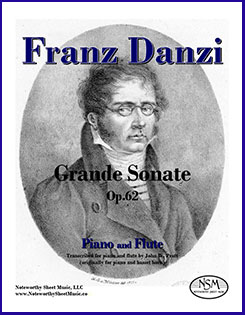 Grande Sonate, Op.62, by Franz Danzi
Grande Sonate, Op.62, by Franz Danzi
transcribed for Piano and Flute by John W. Pratt
Piano score and Flute part, PDF $14.99
excerpted from John Pratt’s foreword to the edition: 'Franz Danzi (1763-1826) was an active musician, cellist, and teacher in Mannheim, Munich, Stuttgart, and Karlsruhe. A prolific composer, especially of music for the stage and chamber music from keyboard solos to sextets, he revered Mozart and mentored Weber. His wind quintets are notable. His Grande Sonate, Opus 62, for piano and basset horn, was published about 1823, along with an alternative cello part which sometimes differs from the basset horn part in other ways than octave transposition. // The sound of the basset horn varies widely, depending on its construction, who is playing, what is being played, and who is describing it. George Bernard Shaw said, ''The devil himself could not make a basset horn sparkle.'' Burnet Tuthill, in Cobbett's Cyclopedic Survey of Chamber Music (1929), wrote of its "soft mellow timbre of rich beauty.” E.T.A. Hoffmann likened its sound to the scent of red carnations (see Georgina Dobré, The Basset Horn, who says, pace Shaw, “Sparkle it certainly can!”). That tent is broad enough to cover the characteristics of both the flute and the clarinet comfortably, and Danzi’s Grande Sonate alternates sparkle and mellow rich beauty in large measure.' Since we at NSM have grown quite fond of this piece, we decided to transcribe it for both flute and clarinet, so we and our friends could enjoy playing it. We offer here the flute edition, with a version for clarinet to follow in the coming weeks.
Piano score, 28 pages; Flute part, 7 pages; Total 40 pages.
PreviewDanzi - Grande Sonate - Piano and Clarinet
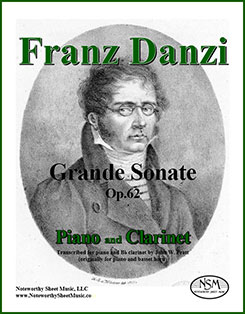 Grande Sonate, by Franz Danzi
Grande Sonate, by Franz Danzi
transcribed for Piano and Clarinet by John W. Pratt
Piano score and B♭ Clarinet part, PDF $14.99
Danzi’s Grande Sonate, Opus 62, written for piano and basset horn, was published around 1823, along with an alternative part for cello. Please see additional information about this piece in the article describing our re-notated basset horn edition. The Grande Sonate comprises four movements and provides both sparkle and mellow rich beauty. It is nicely adaptable to other winds, particularly the clarinet. Certain passages in the final movement of the original work seem to invite elaboration or improvisation by the solo instrument, and arranger John Pratt offers suggestions for possible additions or alternatives for the clarinet, making it even more fun to play.
Piano Score, 28 pages; B♭ Clarinet Part, 7 pages; Total, 40 pages.
PreviewDebussy - Première Rhapsodie - Alto Flute
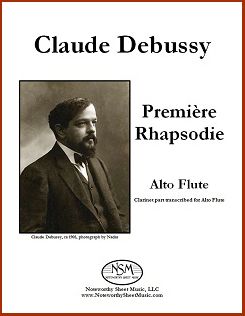 Première Rhapsodie, by Claude Debussy
Première Rhapsodie, by Claude Debussy
Transcribed for Alto Flute by C.A.Vater, with a Foreword by P.H.Bloom
Alto Flute Part ― PDF $5.99
Since its introduction as a morceau de concours for the Paris Conservatoire in 1910, Debussy's Première Rhapsodie has been an essential piece of the clarinet repertoire. ... Although most of the morceaux are, by definition, run-of-the mill exercises of virtuosity à la mode, a number have endured as works of significant musical merit. Debussy's Première Rhapsodie is one such piece. It's a vehicle for expressive interpretation and artistry, with charm, warmth, passion, and humor; a lasting treasure at the core of every clarinetist's collection of indispensable works. ... But a transcription? Of a work by Debussy - the great colorist of instrumental sonority? From clarinet to alto-flute? ... Each and every element, in fact, evokes the alto-flute! ... Of course the piece sounds different on the two instruments. Although the sonic hues are different, the colors are just as vivid. The distinct sonorities of the alto-flute support the nuance, the affect, and the power of the work. (excerpted from Peter H. Bloom © 2012)
We provide our alto flute part only; appropriate parts for piano or orchestral accompaniment may be obtained as free pdf downloads from public domain resources, such as imslp.org.
Alto Flute part, 4 pages; Total, 10 pages.
PreviewDieter - The Golden “Reade” Flute - Flute & Piano
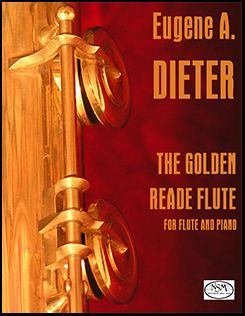 The Golden "Reade" Flute, by Eugene A. Dieter
The Golden "Reade" Flute, by Eugene A. Dieter
Flute Part and Piano Score ― PDF $7.99
Elmer Reade (1898-1986), to whom The Golden "Reade" Flute is dedicated, served a long and distinguished career, first as a flutist with the U.S. Army Band and then as a conductor and music director of the Air Force Band at Mitchell Field, New York. Eugene A. Dieter graduated from the first class of the US Army Music School in 1941 and was appointed a bandmaster. Following the Second World War, Dieter accepted a bandmaster position with the Air Force Band and remained active until his retirement in 1966. Likely, it was as an Air Force band colleague of Elmer Reade's that Dieter was inspired to compose The Golden "Reade" Flute. (excerpted from the foreword © by P. H. Bloom)
Not at all militaristic in character, The Golden "Reade" Flute is more a lovely barcarole, a single Andante moderato movement in 6/8 time. It offers interesting writing for both parts, so flutist and pianist will be equally pleased. The title refers to the gold flute by William S. Haynes upon which Reade regularly performed.
Piano score, 4 pages; Flute part, 2 pages.
PreviewDressler - Portrait Charmant - Flute (or Vn) & Piano
 Portrait Charmant, by Raphael Dressler
Portrait Charmant, by Raphael Dressler
Gassett Collection - Facsimile Edition by C.A.Vater/Noteworthy Sheet Music
Part for Flute or Violin and Piano Score, PDF $3.00
Raphael Dressler (1784-1835) was a well-known Austrian flutist and composer. He wrote more than 100 compositions for flute and published a popular flute method book, New and Complete Instructions for the Flute. His career included a position as first flutist in the Kärntnerthor Theater orchestra in Vienna and many years as a teacher and performer in London. Dressler's Portrait Charmant is the fifth of his Douze Thèmes Favoris pour Pianoforte et Flûte (ou Violon). The piece is a short work, simple yet indeed charming, and playable by flutists (or violinists) and pianists of many skill levels. A favorite of ours, Portrait Charmant can also be played effectively as a solo work for flute or violin alone.
For additional information about the Gassett Collection, please see see our article An Introduction to the Gassett Collection.
Piano score, 3 pages; Flute or Violin part, 1 page; Total, 8 pages.
PreviewDrouet - Salute to New York - Flute and Piano
 Salute to New York, A Song for the Flute, by Louis Drouet
Salute to New York, A Song for the Flute, by Louis Drouet
Edited and with a Foreword by P. H. Bloom
Piano Score and Flute Part, PDF $5.99
We have posted Peter H. Bloom's fascinating and highly informative © foreword to this edition, in its entirety, elsewhere on our website, under Resources - Reviews & Articles, so please visit that page for additional historical details regarding the composer, Salute to New York, the New York Crystal Palace, and Hall & Son's flutes, beyond the short excerpts and paraphrases included here.
Louis-Francois-Philippe Drouet (1792-1873) is one of the most highly esteemed flute virtuosi in history. Innumerable contemporary press accounts of his concert triumphs throughout Europe attest to his technical brilliance and exquisite musicianship. He was a prolific and accomplished composer, author, flute theoretician, and pedagogue. His many etudes are still prescribed as tools for flute mastery. His Method of Flute Playing (1830) and 72 Studies on Style and Taste (1855) provide us with useful information concerning instrumental technique and performance practice in the mid-nineteenth century.
The exquisite Salute to New York, A Song for the Flute was performed by Mr. Drouet at the Crystal Palace in New York, on the occasion of its grand reopening under the new management of showman P. T. Barnum in 1854. Our renotated edition of the piece was edited by flutist Peter H. Bloom, who also has enhanced the original piano score with the addition of chord changes in order to broaden the scope of potential players.
Score, 4 pages; Flute part, 2 pages; Total, 14 pages.
PreviewDvořák - Ballada - Alto Flute & Piano
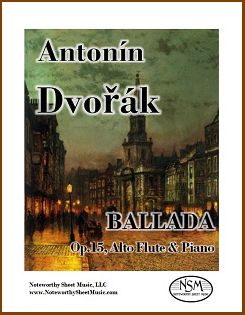 Ballada, Op. 15, by Antonín Dvořák
Ballada, Op. 15, by Antonín Dvořák
Transcribed for Alto Flute and Piano by C.A.Vater
Alto Flute Part and Piano Score, PDF $7.99
The Czech composer Antonín Leopold Dvořák (1841-1904) first visited England in 1884, at the invitation of the Philharmonic Society of London. He conducted several of his works there and and was commissioned to compose a new symphony for the Philharmonic Society, his Symphony No. 7 in D minor, Op.70, which he conducted in London on April 22, 1885. Dvořák, who was well-received in England for his longer works, including cantatas and oratorios, was asked by London publishers to write shorter compositions as well. The Ballada, composed by Dvořák in late 1884 shortly after he completed his Symphony No. 7, was written specifically for publication in the Christmas edition of the London Magazine of Music. It is a short work of approximately six minutes duration for violin and piano. Written in the key of D minor, the Ballad's outer sections are solemn and melancholy while the contrasting central Allegro agitato is fervid and intense. The piece works nicely on alto flute, and our transcription required few adaptations from the original violin part.
[Sources for Dvořák biographical information: Baker's Biographical Dictionary of Musicians (Eighth Edition, Revised by Nicolas Slonimsky) and the internet website http://www.antonin-dvorak.cz/en/ballad.]
Score, 8 pages; Alto Flute part, 3 pages; Total, 14 pages.
PreviewDvořák - Romantic Pieces - Alto Flute
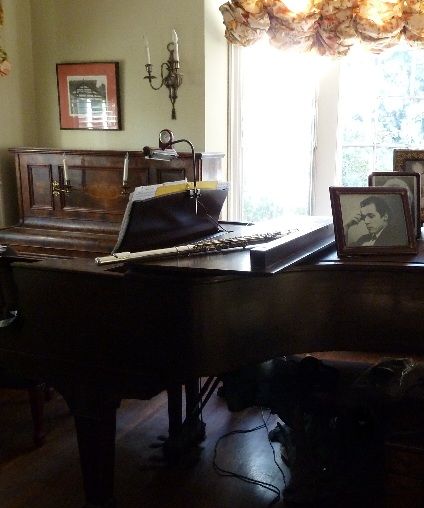 Romantische Stücke, Op.75, by Antonín Dvořák
Romantische Stücke, Op.75, by Antonín Dvořák
Transcribed for Alto Flute (and Piano) by J.W.Pratt and C.A.Vater
Alto Flute Part, PDF $6.99
Antonin Dvorak's Romantische Stücke (Romantic Pieces) was composed originally as a trio for two violins and viola but was later rearranged by the composer as a piece for violin and piano. We created a transcription of the violin part for alto flute; the piano part is readily available in the public domain as a free pdf download of the score for violin and piano. Here is a link to one such source: Piano Score.
Alto Flute part, 7 pages; Total, 10 pages.
PreviewDvořák - Sonatina - Alto Flute
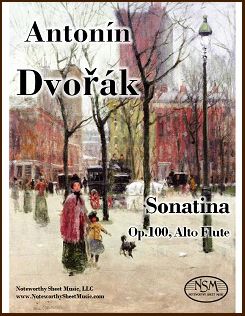 Sonatina, Op.100, by Antonín Dvořák
Sonatina, Op.100, by Antonín Dvořák
Transcribed for Alto Flute (and Piano) by J.W.Pratt and C.A.Vater
Alto Flute Part, PDF $11.99
Czech composer Antonin Dvorak wrote his charming Sonatina in G major for violin and piano in 1893, during his stay in the United States. Intended for Dvorak's own children but no less delightful for 21st century players of all ages, the piece is comprised of four short movements. We provide here a transcription of the violin part for alto flute, which suits the "New World" feeling especially well. We provide the alto flute part; the piano part is readily available in the public domain as a free pdf download of the score for violin and piano. Here is a link to one such source: Piano Score
Alto Flute part, 13 pages; Total 16 pages.
PreviewElgar - Chanson de Matin - AFl & Pf
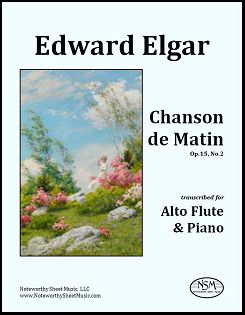 Chanson de Matin, Op.15, No.2, by Edward Elgar
Chanson de Matin, Op.15, No.2, by Edward Elgar
Transcribed for Alto flute and Piano by C.A.Vater
Alto Flute Part and Piano Score, PDF $6.99
Edward Elgar composed his Chanson de Matin for violin and piano c.1889-1890. The two companion pieces, Chanson de Matin (No. 2) and Chanson de Nuit (No. 1), together constitute his Op.15, and both pieces were later arranged for small orchestra by the composer. Chanson de Matin was received with great enthusiasm, and its initial and lasting popularity can be attributed largely to its strong melodic appeal. Enduring public affection for the piece has spawned the creation of numerous arrangements and transcriptions, including renditions for cello and piano, viola and piano, flute and guitar, piano solo, organ solo, and string quartet. Noteworthy Sheet Music offers two of our own transcriptions of the lovely Chanson de Matin, one for alto flute and piano and one for C-flute and piano.
Alto Flute part, 2 pages; Piano Score, 4 pages; Total, 12 pages.
Preview